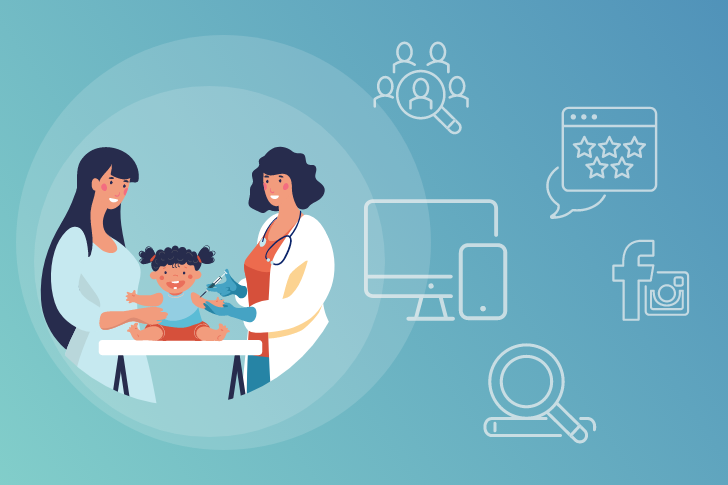9 Strategies That Build Trust and Empower with Healthcare Patient Education
Digital platforms like Officite offer an accessible and engaging way to offer patient education, empowering them to make informed decisions about their health. These platforms highlight the importance of patient education by providing clear, accurate information online, which helps medical practitioners demystify their practices. This, in turn, helps patients understand the benefits of proper healthcare and how it aligns with their overall wellness goals.
Patient education tools like videos, blogs, and social media content allow healthcare practitioners to reach a broader audience. This content can be tailored to address common concerns, debunk myths, and explain complex concepts in an easily digestible format. By making this information readily available, healthcare practitioners can reduce patient anxiety, build trust, and encourage proactive health management. During the COVID-19 pandemic, maximizing patient education efforts through digital tools has become crucial for meeting reimbursement standards and achieving better health outcomes.
Officite’s professional and expertly built healthcare websites are built for the most challenging conditions in today’s digital marketing landscape. If you want your website to become a more profitable investment, we have the answers.
Patient education also fosters continuous learning, informing patients about new techniques, treatment options, and self-care strategies. This ongoing patient education helps patients actively participate in their recovery and long-term health, leading to better outcomes and higher satisfaction.
1. Deploying Digital Communication Tools
An efficient online booking system is crucial for enhancing patient convenience and engagement in today’s busy world. This system simplifies the scheduling process, allowing patients to book their medical appointments with ease and at their own convenience.
By providing a straightforward and user-friendly experience, the system helps patients save time and reduces the chances of scheduling errors. Patients can easily view available slots, select the most suitable times, and even set reminders, all from the comfort of their own homes.
This seamless booking experience greatly improves patient satisfaction and adherence to their treatment plans, making it a logical component of patient education – precisely because patients learn more about how to take care of their health with these tools that educate patients about their health.
When it’s easy for patients to schedule and manage appointments, they’re more likely to stick to their care routines. Additionally, this approach gives patients a sense of control over their healthcare journey, empowering them to take an active role in their wellness.
Video consultations and telehealth services offer a convenient way for patients to connect with their doctors from anywhere. These digital tools allow for detailed discussions about symptoms, treatment options, and other concerns, making healthcare more accessible and less intimidating. Patients can receive personalized advice without leaving their homes, making it easier to integrate care into their busy lives.
For new patients, telehealth services are another component of patient education that provide an opportunity to discuss their concerns and learn about patient care in a relaxed setting. This can help ease anxiety about their first in-person visit, building trust and confidence in the process. Telehealth is also valuable for ongoing patient education, enabling continuous monitoring and timely adjustments to care plans based on real-time feedback. Healthcare professionals play a crucial role in using these tools to enhance patient education, ensuring that patients understand their conditions and treatment plans effectively.
Easily offer the biggest and most exciting digital communications tools on the market today through Officite’s websites. Click here to speak with a Web Presence Advisor.
Enhancing Health Literacy with Digital Aids
Interactive digital charts and diagrams are essential tools in patient education for explaining complex medical concepts like nerve interference and spinal dysfunction. These visual aids simplify the process of understanding the underlying causes of symptoms such as neck and back pain. By clearly illustrating these issues, digital aids contribute significantly to health education, enabling patients to better grasp how healthcare can alleviate discomfort and improve overall well-being. This visual method not only enhances understanding but also fosters a deeper appreciation for the benefits of different medical treatments.
Video tutorials and animations are powerful educational tools for patients learning about different therapies and medical services. These resources offer detailed visual explanations that make it easier for patients to understand and follow their treatment plans. Step-by-step video guides are particularly effective, helping patients perform recommended exercises and therapies correctly, which contributes to better treatment outcomes. Providing patient education materials in clear, accessible language further enhances patient understanding and engagement in their health care.
Technologies like 3D models and virtual reality (VR) technology, for example, significantly enhance patient understanding of anatomy and treatment procedures. Tools like a 3D Spine Simulator allow patients to visualize their spinal issues and the impact of proper spinal care. This immersive approach helps patients better understand their conditions and the potential benefits of their treatments, ultimately boosting their satisfaction and engagement in their healthcare journey.
Comprehensive Patient Education Resources
Offering e-books and downloadable guides on common health issues such as asthma, heart disease, diabetes, knee pain, and chronic disease provides patients with valuable information they can access anytime, making patient education even more practical for your patients.
These resources empower patients by helping them understand their conditions and treatment options, allowing them to make more informed decisions about their care. Additionally, these resources improve health literacy by ensuring patients can comprehend medical information, navigate healthcare systems, and follow medical advice effectively.
Blog articles are an excellent way to explore various topics in patient care, from alternative therapies to the benefits of regular adjustments. These articles provide in-depth insights and practical advice, helping patients stay informed and engaged in their health journey. By offering detailed information, blogs encourage patients to take an active role in their care, which can lead to better health outcomes and greater satisfaction.
Curated lists of trusted external resources for patient education provide patients with additional information on specific conditions, treatments, and health strategies. By offering these resources, medical practitioners can enhance patient education without having to create all content themselves. These lists help patients explore topics in greater detail, supporting their ongoing education and engagement in their care.
Officite’s websites are beautifully made digital platforms that can present an innumerable number (and volume) of patient education resources. From the most relevant healthcare blogs to the most engaging healthcare-themed videos posted on a medical website or originally posted on social media and video-streaming websites like YouTube, there’s always something more to offer your patients with the right website built to cater to the needs of today’s consumers. To learn more about Officite websites and marketing solutions like patient education, fill out the form below.
Patient Centered Medical Websites & Marketing Solutions
4. Custom Digital Care Plans
Healthcare providers play a crucial role in delivering personalized care through customized patient portals. These portals provide individualized treatment plans, educational resources, and tools for tracking progress. By giving patients access to information specific to their conditions and treatments, these portals enhance patient understanding and involvement in their care.
Regular follow-ups and check-ins through email or messaging apps are crucial for maintaining clear communication between medical practitioners and their patients. These ongoing digital interactions help patients stay informed about their progress and any necessary adjustments to their care plans. This consistent engagement also opens a line of communication, allowing medical practitioners to provide timely advice and support, which improves patient compliance and outcomes. Regular follow-ups are an integral part of the patient education process, ensuring that patients are continuously supported and informed.
5. Training Your Team for Better Patient Education
Health care professionals play a crucial role in patient education, and online training modules for staff ensure consistent and effective patient communication and education. These modules cover key topics like explaining treatment options, managing patient handouts, and using digital tools effectively. Standardized training helps ensure that all team members provide clear, accurate information, which enhances the overall quality of patient interactions and improves patient satisfaction.
Virtual workshops and webinars keep teams updated on the latest digital tools and patient education strategies. These sessions promote a cohesive approach to patient care by providing a platform for learning and discussion. By staying informed about new developments and best practices, team members can offer accurate and consistent information to patients, which contributes to better patient outcomes. The importance of patient education practice guidelines, developed by the Health Care Education Association, cannot be overstated as they provide a structured framework to assist healthcare professionals in delivering effective patient education.
6. Using the Latest Digital Tools in Patient Education
Online patient management systems streamline the organization of patient information and educational content. These systems efficiently manage data, track progress, and ensure patients have easy access to essential resources. By centralizing information, these systems enhance the efficiency of the practice, reduce administrative burdens, and improve the overall patient experience. They also enable personalized care and support, helping patients stay informed and engaged in their treatment journey. Additionally, patient education handouts play a crucial role in providing essential resources, ensuring uniform and standardized patient education methods to improve patient understanding and engagement.
Mobile apps are valuable for engaging patients in their treatment plans. These apps provide reminders for exercises and appointments and offer easy access to educational resources. By using mobile apps, patients can stay committed to their care regimen, track their progress, and receive timely information, all from their smartphones. This convenience helps patients adhere to their treatment plans and enhances their overall experience and outcomes.
Online scheduling and communication platforms simplify the process of booking appointments and staying in touch with healthcare practitioners. These platforms enhance accessibility and convenience, allowing patients to manage their healthcare needs easily. With a user-friendly interface for scheduling, rescheduling, and communicating, patients can stay engaged with their treatment plans and receive timely care.
Virtual Communities for Patient Engagement
Online workshops and webinars are effective tools for engaging patients and the broader community in the name of effective patient education. These events offer valuable learning opportunities and help participants understand the benefits of modern patient care.
By hosting these sessions, doctors can address common concerns, explain treatment options, and share preventive strategies, fostering a sense of community and encouraging broader participation. Patient education materials can also be shared in these virtual communities to further enhance understanding and engagement.
Social media is a powerful tool for sharing content from patient education and engaging with patients. By posting informative articles, videos, and event announcements, healthcare practitioners can foster a sense of community and encourage patients to take an active role in their health journey. Social media platforms also provide an excellent opportunity to share insights, answer questions, and highlight success stories, helping to build stronger relationships with patients.
Online forums and support groups offer patients a platform to share experiences, ask questions, and receive support. These groups facilitate patient education by allowing members to exchange knowledge and discuss their conditions and treatment options. Additionally, the emotional support from peers going through similar experiences can be incredibly reassuring and empowering. By fostering a supportive online community, doctors can enhance patient engagement, encourage continuous learning, and help patients feel more connected and understood throughout their healthcare journey.
8. Maintaining Transparency in Healthcare
Providing detailed online information about treatment options is essential for improving health literacy and helping patients make informed decisions about their care. This transparency builds trust between patients and healthcare practitioners, ensuring that patients fully understand what to expect from their treatment. By clearly outlining the benefits, risks, and expected outcomes, patients can make informed choices that align with their health goals.
Setting clear and realistic expectations for treatments is vital for managing patient expectations and reducing misunderstandings. By providing detailed information about likely outcomes and potential limitations, patients are better prepared for their healthcare journey. This transparency builds trust and reassures patients, fostering a positive and supportive relationship.
Offering transparent information about costs and insurance coverage is crucial for helping patients understand their financial responsibilities. By providing clear explanations of fees, payment options, and insurance coverage, patients can better plan and budget for their care, reducing confusion and surprises.
9. Integrating Patient Feedback into the Loop
Online surveys and feedback forms are effective tools for gathering patient insights. These tools enable healthcare practitioners to collect opinions on various aspects of the patient experience. By analyzing this feedback, doctors can identify areas for improvement and make informed decisions to enhance the quality of care provided. Feedback can also be used to improve patient education efforts, ensuring that patients are well-informed and engaged in their care.
Making changes based on patient feedback demonstrates a commitment to continuous improvement. By actively listening to patients and addressing their concerns, healthcare practitioners can enhance patient education and satisfaction. This commitment to adapting and improving helps create a more positive and effective experience with your healthcare practice.
Sharing patient testimonials and success stories online is a powerful way to build credibility and attract new patients. These stories serve as proof of the effectiveness of patient care and help to reassure prospective patients. By highlighting the positive experiences of others, healthcare practitioners can inspire confidence in potential patients and encourage them to seek care.
The Long View of Patient Education in Healthcare
The future of patient education in healthcare is fully embracing digital transformation, highlighting the importance of patient education in improving patient outcomes and engagement. By integrating online tools and resources into patient education strategies, healthcare practitioners can provide more personalized, accessible, and effective care. This approach not only enhances patient understanding and engagement but also positions practices as forward-thinking and patient-centered.
As technology continues to evolve, doctors must stay updated with the latest digital tools and strategies. This ongoing commitment to innovation ensures that patient education remains relevant and effective. By continually adapting to new advancements, doctors can provide the highest level of care, ensuring that patients receive the information and support they need to achieve optimal health outcomes.
Digital patient education has a lasting impact on the medical profession. By leveraging digital tools, healthcare practitioners can empower patients with the knowledge and resources they need to take control of their health. This empowerment not only improves individual patient outcomes but also enhances the overall reputation and effectiveness of healthcare.
About Officite
Officite provides independent practices professional website design, patient acquisition services, and premier healthcare digital marketing. Our industry-leading solutions include SEO, reputation management, social media, and more.

Maryrose Dooley expertly guides small practices through the digital landscape, offering marketing strategies to attract more patients. Her unique blend of business acumen and design expertise creates visually appealing solutions that set businesses apart. With a passion for leveraging technology, Maryrose helps businesses of all sizes achieve their goals and stand out from the competition.



